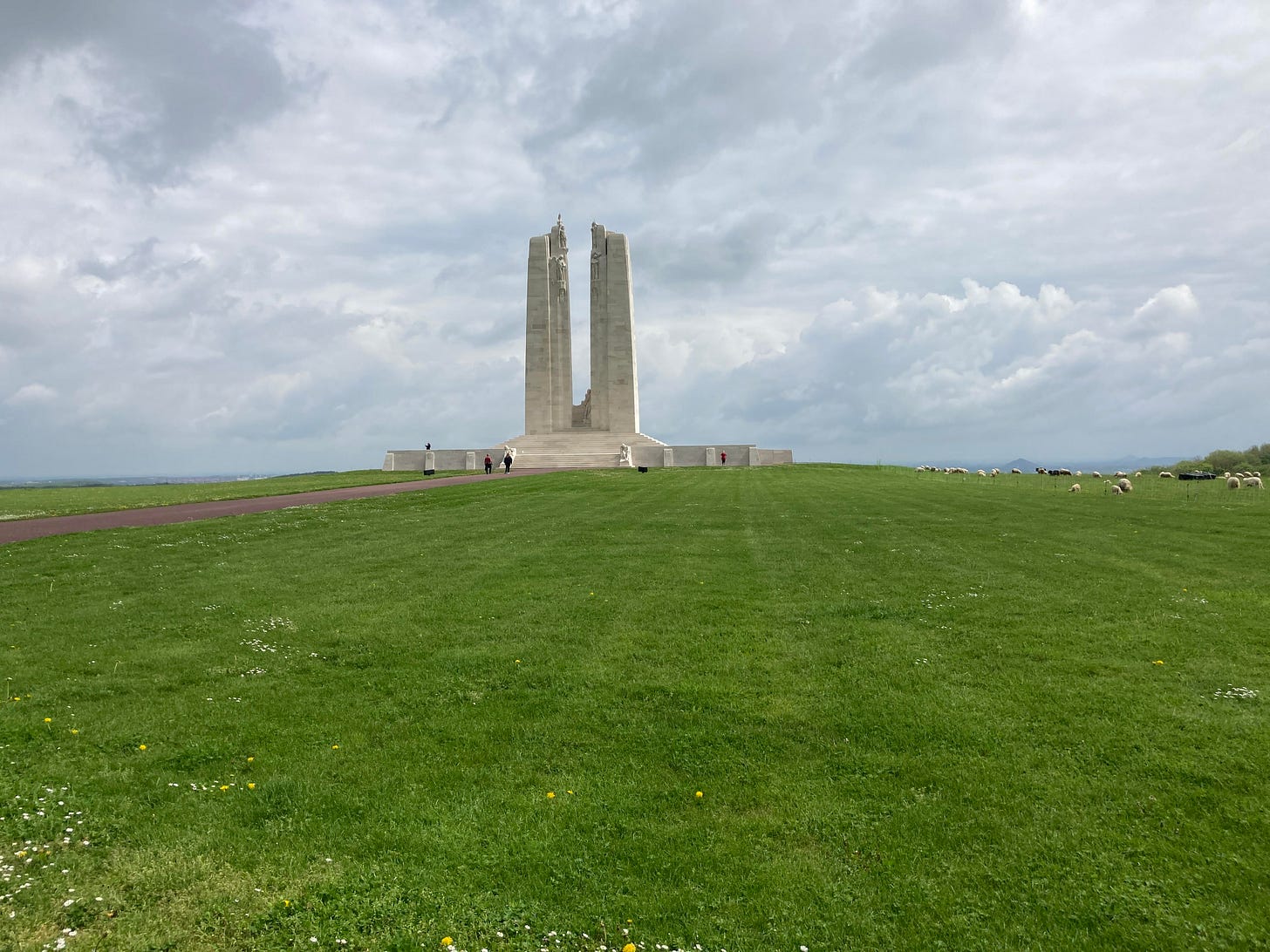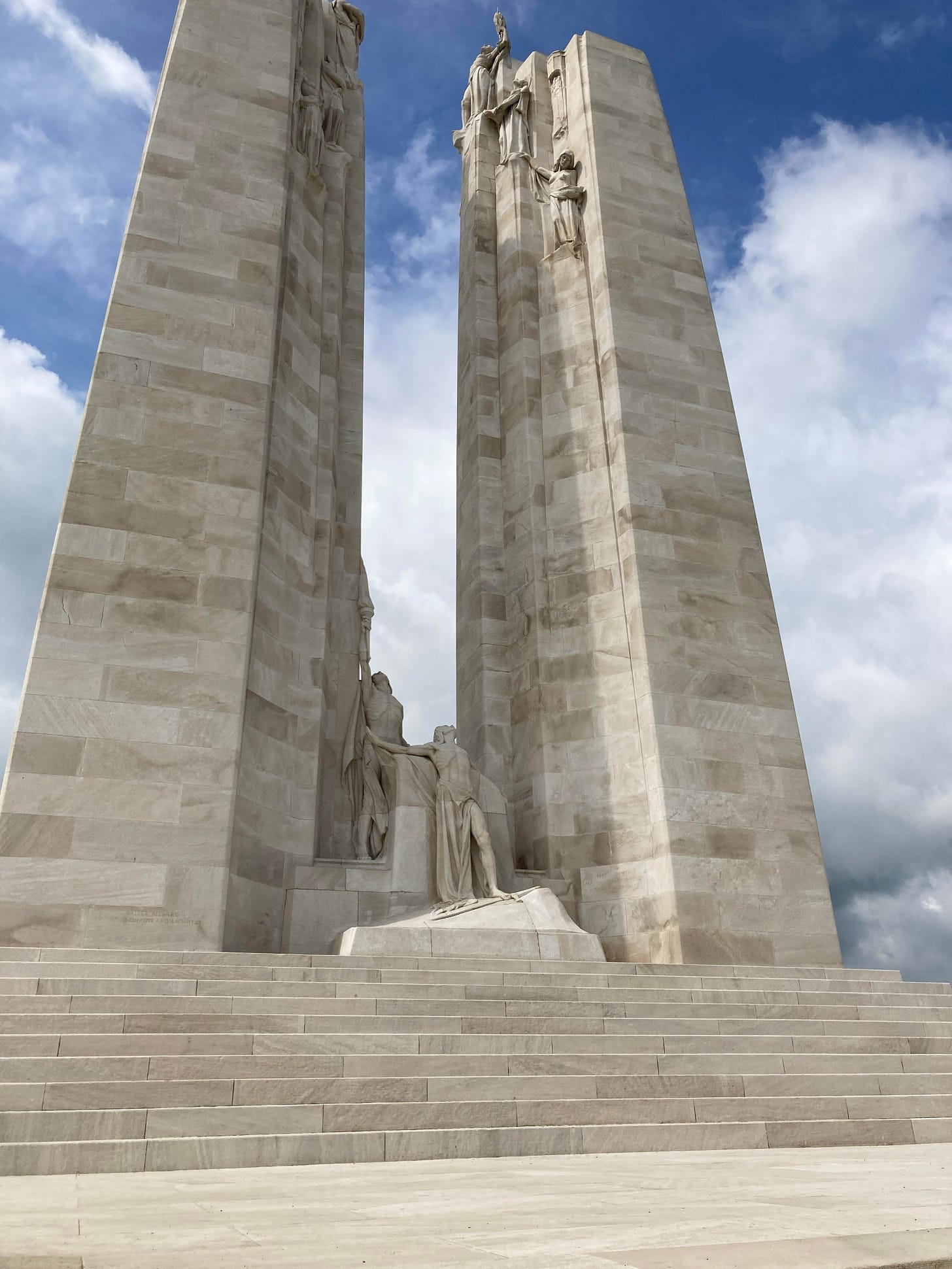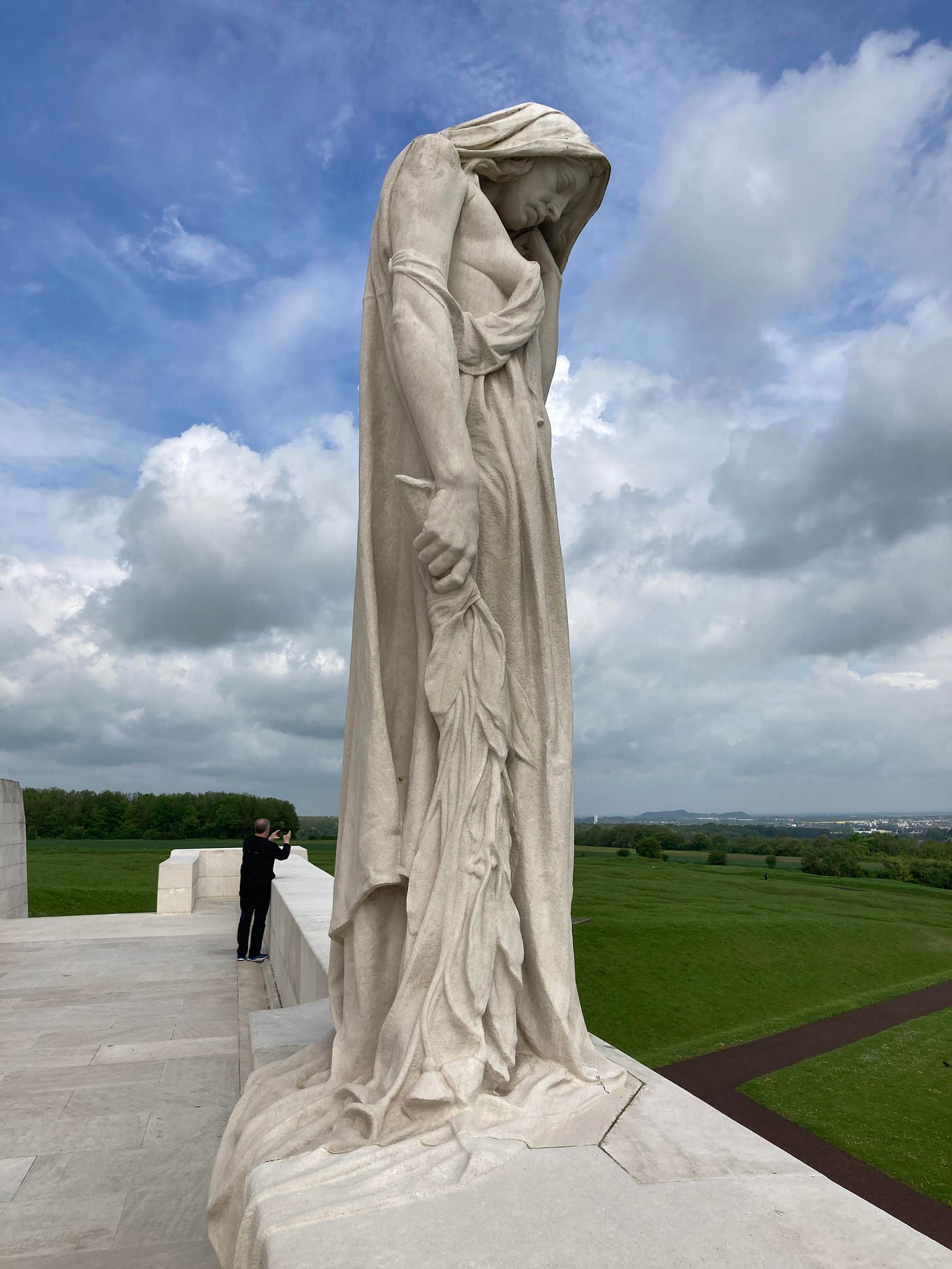The monument the world doesn’t know
The Vimy Ridge shrine is among the most emotionally powerful objects ever built by humanity.
Your writer and wife spent the first half of this month in Europe, mainly the Netherlands, visiting one of our children, who lives in Amsterdam. We were there on May 4, Netherlands Remembrance Day. At 8 P.M. local the entire nation fell silent as mournful bugles played, followed by church bells. We were in a trendy beer garden of a big urban park, packed with trendy young people (plus us!). Everyone was perfectly silent.
Vimy Ridge complex from a distance. Photos by me on an iPhone SE.
Soldiers ask to be remembered. Let’s hope Europe never forgets what the Nazis stole from humanity, and whom the Nazis served.
I thought this would be the emotional peak of the trip – and was I ever in for a surprise.
Later wife and I boarded the Thalys, reaching Lille, France, then took a local to the tiny rural hamlet of Vimy, where the train simply lets you off at a grade crossing – no station.
“Let’s call an Uber,” yours truly naively said. Might as well have said, “Let’s saddle up the nearest cow.”
Near the grade crossing was a quintessential French country store -- selling feed, seeds, tools and alcohol. My wife’s French is good; she explained our predicament to the proprietor. He called a cabbie friend in Arras, the nearest city, who came to snatch us up. Most likely the storeowner wanted to get these strange visitors out of his place of business. Though, I suspect the Americans who arrived thinking there would be Ubers in the French countryside were the talk of Vimy that day.
The cabbie drove us to our destination, the Canadian National Vimy Memorial, which took my breath away.
I’ve lived a fortunate life, seen many amazing sights -- but never anything like this memorial. I don’t know why it is not globally recognized. Perhaps because Vimy is hard to reach. Perhaps because of the word Canada, an internationally recognized punchline.
Whatever the reason, the Canadian National Vimy Memorial should be on your travel list. It is among the most emotionally powerful objects ever built by humanity.
In early April 1917, four Canadian divisions assaulted the German position on Vimy Ridge, an escarpment on the northern French plain that was a center of so much suffering in both world wars.
Four thousand Canadians died, along with a similar number of Germans. The awful battle ended with the attackers in possession of Vimy Ridge. Across Canada there was wild celebration: the first time a Canadian army had defeated the army of a great power.
A few years later the phrase “Vimy Ridge” became part of the argument Canada should receive from Britain home rule, similar to that granted the Republic of Ireland. (We forget how recent Canada’s political history is – Newfoundland not joining till 1949, the nation not fully sovereign till 1982.)
The battle was the horrible waste and slaughter of the Great War encapsulated in one place – men dying in all directions to gain or defend a rim of land with no larger significance.
Of Canadians who went to France to fight in the Great War, one in 10 never came home. For Americans at the same place and time the figure was one in 35. Austria, England, France, Germany, Ireland, Italy, Russia and Turkey had worse casualty rates. But for Canada, a mainly volunteer force with no direct stake in the Great War, deaths were painfully numerous.
Today Canadians look back on Vimy Ridge as a great triumph for their ascendant polity. In a sense it was. But imagine it’s 1917 and you are telling your 18-year old son, “Go to France to die running up a hill so that Canada can become a real country someday.”
I have two strong ties to Vimy Ridge, which will be detailed in a moment.
First, the memorial itself.
Designed by the sculptor of monuments Walter Seymour Allward, the site took 11 years to build. Allward spent a full year selecting materials, notably limestone from an ancient Roman quarry in Croatia, stone that weathers exceptionally slowly. It was worth the effort – a century later, etchings on the memorial are distinct and easily read.
The monument covers 250 acres with pedestal and spires at the center of the escarpment, dominating the view in every direction. Trenches, tunnels and battlements were left in place, today overgrown but clearly visible.
Because the two pylons are asymmetrical, at the time the memorial design was denounced as modernist. Today, it strikes the viewer as traditionalist.
The pylons, with figures attempting to ascend; below them are figures lamenting.
The twin pylons are about 90 feet tall; the pedestal places them about 350 feet above the plain where most of the battle was fought. Because the plain around the memorial is flat, the impression is one of immense scale.
Standing at the base of the pylons and looking up made me feel dizzy, as if I needed to grab hold of something.
Numerous human figures are sculpted into the pylons and base, weeping or looking dejected.
On the back side of the memorial stands a single statue of a goddess, titled Canada Bereft, who mourns for the fallen. Around the base are etched the names of the 11,285 Canadian men lost in the war whose bodies were never found. The power of the lonely spires and bereft statues is hard to convey with pictures, overwhelming in person.
Canada Bereft.
There are of course many memorials to the dead of the two world wars in France and other nations. There aren’t any in Germany, because Germany has nothing to be proud of. Even with Germany now a liberal democracy it is vital all bear in mind, Germany has nothing to be proud of.
Gazing on the memorial ones thinks of the men dying there believing they had accomplished something magnificent that would never be forgotten – and outside of Canadian high-school civics classes, it’s forgotten. But should not be; if you are in France or visiting France, you should go.
Personal links. My mother, born in Toronto in April 1917, was named Vimy, because she came into the world right after the sensational news of the victory. She disliked her unusual name, and never went to see Vimy Ridge, where the memorial was completed in 1936.
My father’s father, Harry Edmund Easterbrook, enlisted for the Canadian force in the Great War, shipping out to France in early 1917. He developed a kidney disease and was sent home, dying of nephritis a few years later at age 30.
A newly built museum at the Vimy Ridge memorial offers access to the Canadian National Archive, which allowed me to look up Harry’s military and medical records.
Included in his files was the paperwork of a long, unsuccessful campaign by my father’s mother for a widow’s pension. Many docs and administrators with lengthy titles wrote memos saying Harry died of an existing condition, not a military injury, and therefore his life was worth nothing.
Harry left no life insurance and in those days there was no welfare state. The ruling consigned my father, his three siblings and my grandmother to years of poverty.
My father, George Edmund Easterbrook -- I am Gregg Edmund and our son in Amsterdam is Grant Edmund -- was three years old when Harry died. My dad lived a good, full life; his primary regret was never knowing his own dad. I am glad that I knew mine, and that my three children know me.
But how was that possible?
Staring at the pylons of the memorial and the pixels of the archive’s computer, I realized that when Harry reached France, only my father’s older brother had been born. My dad and his two younger siblings had not yet arrived.
Supposing Harry was judged fit for combat, perhaps he would have died in northern France – and then I and my three children never would have come into existence, nor my two brothers and many others.
When we think about the hideous losses of war, we tend to focus on the soldiers, nurses and bystanders who die as the direct result of combat. We should think, as well, of those who are never born.
Go to Vimy Ridge and spend a day contemplating this.
Bonus: Advice for Visiting Vimy Ridge. Take the train to Arras, not to Vimy; or rent a car.
Bonus: If You Can’t Get Into the Vermeer Exhibit… In Amsterdam we went to the Resistance Museum. The politics and design of the new exhibit are controversial. To me the presentation seemed straightforward – Nazi occupation was horrible, how could a museum about something horrible not be full of horrible things? Better to deal with the memory than avoid the subject.
Bonus: Great War Lit. It can be argued – hmmm, perhaps I will – that World War I produced better literature than World War II.
Most Great War literature focuses on slaughter and the Lost Generation notion that millions died because Austrian, British, French, German, Russian and Turkish aristocrats wanted to cling to their robes of gold. A century later, this interpretation remains strong.
Here are the Great War novels not to miss:
All Quiet on the Western Front by Erich Remarque. In German the title means “no news from the Western front” more than “quiet.” A landmark novel.
One of Ours by Willa Cather. Praised by yours truly here
https://greggeasterbrook.substack.com/p/who-was-the-best-american-novelist
A Farewell to Arms by Ernest Hemingway. This book wanders inconclusively, then accelerates to one of literature’s unforgettable endings. Example of a novel that’s average in quality but everyone should read.
The Lie by Helen Dunmore. You will guess the secret by page five. Still, well worth reading.
The Regeneration Trilogy by Patricia Barker. Sold as three novellas, is really one long novel. The final book, The Ghost Road, will haunt you.





I was really surprised that there are no World War memorials for the fallen German soldiers in Germany. In Hungary (the other country that lost both World Wars) many villages and towns have such memorials. In many cases the memorial was created after World War I, then updated after World War II. The memorial in my town, which has my great grandfather's name written on it, even has a section for those who died during the 1956 Revolution.
this is an important point thank you for saying it